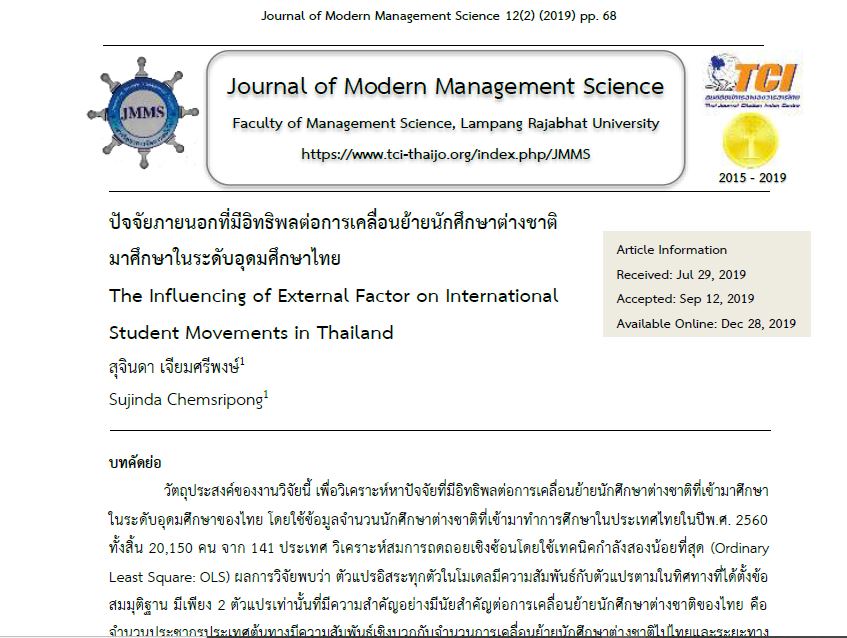The Influencing of External Factor on International Student Movements in Thailand
Main Article Content
Abstract
The purpose of this research aims to analyze the influencing of external factors on international student movements in higher education in Thailand. Data access on 20150 student from 141 home countries, according to the number of all International students who studied in Thailand in 2017. Multiple Regression equations by using ordinary least square has been applied. Research has been found that the population of the home country has a positive correlation with the number of the movement of international students in Thailand. On the other hand, the distance between the home and host countries has a negative relation. Therefore, the Government should pay priority attention to defining a clear target group countries, to launch a marketing strategy to increase the number of foreign students from these countries.
Article Details
The article must be considered and accepted for publication by the editorial board of the Faculty of Management Science, Lampang Rajabhat University. The articles have been reviewed by a peer (peer review) and the author must update according to the suggestion if available before publication. Articles that are not considered the editorial team will inform the results of the consideration but will not send the original to the author.
JMMS is the Faculty of Management Science journal, Lampang Rajabhat University. Jmms published both print and online editions. We allow the use of articles for academic use under the scope of copyright law.
References
ชัยวัฒน์ ปัญจพงษ์, ประภาเพ็ญ สุวรรณ และ ณรงค์ เทียนส่ง. (2521). ประชากรศึกษา. กรุงเทพฯ: ไทยวัฒนาพานิช
2521. 198.
มาลี โชคล้ำเสิศ, อธิบดีกรมส่งเสริมการค้าระหว่างประเทศ, กระทรวงพาณิชย์. (2560). “การสร้างโอกาสธุรกิจบริการ
การศึกษานานาชาติไทยสู่สากล”,บทสัมภาษณ์ในงานสัมมนา, วันที่ 20 มิ.ย. 2560
Agarwal, V., & Winkler, D. (1985). Foreign Demand for United States Higher Education: A Study of Developing Countries in The Eastern Hemisphere, Economic Development And Cultural Change, Vol. 33, No.3, pp.623-44.
Banks, M., Olsen, A. & Pearce, D. (2007), Global Student Mobility: An Australian Perspective Five Years, On IDP Education, Adelaide.
Becker, R., & Kolster. R. (2012). International Student Recruitment: Policies and Developments
In Selected Countries. The Hague: Netherlands Organization for International Cooperation in Higher Education (Nuffic).
Böhm, Meares, & Pearce (2002). Global Student Mobility 2025: Forecasts of the Global Demand for
International Higher Education. Working Paper IDP Education Australia, September 2002.
Böhm, A. et al. (2004). Forecasting International Student Mobility: A UK Perspective, British Council, London.
Chapman, R. (1979). Pricing Policy and the College Choice Process. Research in Higher Education, 10(37), 57.
Dennard, E. (2000). The Influence of Psychosocial Factor on College Choice and Subsequence
Student Satisfaction with College Experiences. Dissertation Abstracts International.
Follari M. (2004), Comparative Costs of Higher Education for International Students 2004, IDP Education Australia.
Freeman, Y., & Freeman, D. (1992). Whole language for Second Learners. Portsmouth, NH
Heinemann.
Gustav, C., (1921). The World’s Monetary Problems; Two Memoranda. London, Constable.
Jones, E. (2002). Factors that Influence College Choice for African Student. Thesis (PhD.)
Union Institute and University. Retrieved from https://thailip-db.car.chular.ac/dao/detail.nsp.
Kim, J. (1998), Economic Analysis of Foreign Education and Students Abroad’, Journal of
Development Economics, 56, 337-65.
Knight, J. (2005). Cross-border Education: An Analytical Framework for Program and
Provider Mobility’, in Smart, J. & Tierney, W. (eds), Higher Education: Handbook
of Theory and Research, Volume 21, Springer, Dordrecht.
Knight, J. (2006). Cross-Border Education: Conceptual Confusion and Data Deficits. Perspectives in Education, December 2006, V.24(4), 15-28.
Lee, E. (1966). A Theory of Migration. Demography, 3(1), 47-57.
Mazzarol, T., Kemp, S. & Savery, L., (1997), International Students Who Choose not to Study in Australia: An Examination of Taiwan and Indonesia, Australian International Education Foundation, Canberra.
Mazzarol, T., & Soutar (2002). Push-Pull Factors Influencing International Student Destination Choice.
International Journal of Education Management, 16(2),82-90. Retrieved from
https://doi.org/10.1108/09513540210418403 Downloaded on: 23 February 2019.
McMahon, M. (1992). Higher Education In A World Market: An Historical Look At Global Context
of International Study. Higher Education, 24, 465-82.
McLeod, M. (1997). Marketing Survey of PJC Students, Pensacola Junior College. Florida Office of
Institution Research and Effectiveness.
Menon, M. (1997). Perceived Rates of Return to Higher Education in Cyprus. Economic of Education Review 16:425-430.
Miller, C., & Byrnes, P. (2001). To Achieve or not to Achieve: A Self-Regulation Perspective on
Adolescents’ Academic Decision Making. Journal of Educational Phycology, 93,(4), 677-685.
Murphy, E. (2002), Student Mobility and Narrative in Europe: The New Strangers, Routledge, London
Naidoo, V. (2007). The Flow of International Students to UK Universities: Determinants and Implications. Journal of Research in International Education. Retrieved from https://journals.sagepub.com/doi/10.1177/1475240907083197
OECD (2004), Internationalization and Trade in Higher Education: Opportunities and Challenges, Organization for Economic Cooperation and Development, Paris.
Pakko, M., & Pollard, P. (2003), Burger-nomics: A Big Mac TM Guide to Purchasing Power Parity.
Federal Reserve Bank of St. Louis Review 85(6), 9-28.
Palika, B. (2003). The Effect of Study Abroad and Personality on Employment and Earnings in
Maxico, Dissertation Abstract International. No. DA.3118052.
Pettibone, S. (2001). A Study of the Value Beliefs and Attitude of Students at an International High
School. Doctoral Dissertation, Education, Boston University.
Raychaudhuri, A. & De, P. (2007). Assessing Barriers to Trade in Education Services in Developing Asia-
Pacific Countries: An Empirical Exercise. Asia Pacific Research and Training Network on Trade
Working Paper Series, No. 34, May 2007. 1-57. Retrieved from www.artnetontrade.org.
Shackleton, J. (2003). Opening Up Trade in Higher Education: A Role for The GATS?. World Economics, 4(4), 55-77.
Tierney, M. (1983). Student College Choice Sets: Towards an Empirical Characterization. Research in Higher Education, 18, 271-84.
Tremblay, K. (2001). Student Mobility Between and Towards OECD Countries: A Comparative Analysis. in OECD International Mobility of Higher Skilled, OECD, Paris, 39-67.
UNESCO-OECD (2005), Guidelines for Quality Provision in Cross-border Higher Education, UNESCO and
OECD, Paris.
UNESCO. (2015). Definition of International Student Migration. Retrieved from
https://migrationdataportal.org/themes/international-students
World Bank (2019). World Development Indicators. Retrieved from
https://datatopics.worldbank.org/world-development-indicators/themes/people.html
Webmetrics. (2019). Ranking of World University. Retrieved from www.webometrics.info/en
WTO (2001). Guide to the GATS: An Overview of Issues for Further Liberalization of Trade
in Services, World Trade Organization, Kluwer Law International, The Hague.
Zuker, R. (2004). Factors to Consider in Selecting a College. Retrieved from
https://www.thehighschoolgraduate.com/educational/DF/factor.html.

